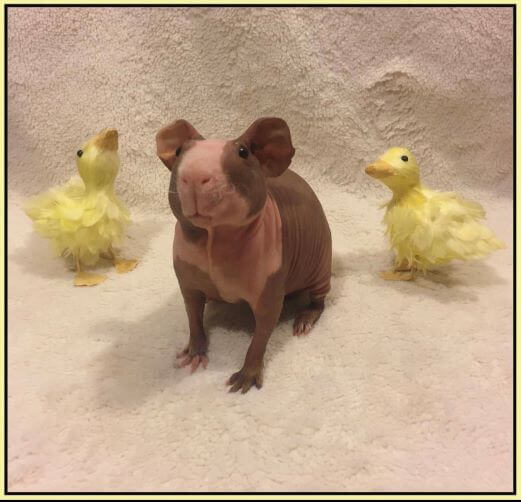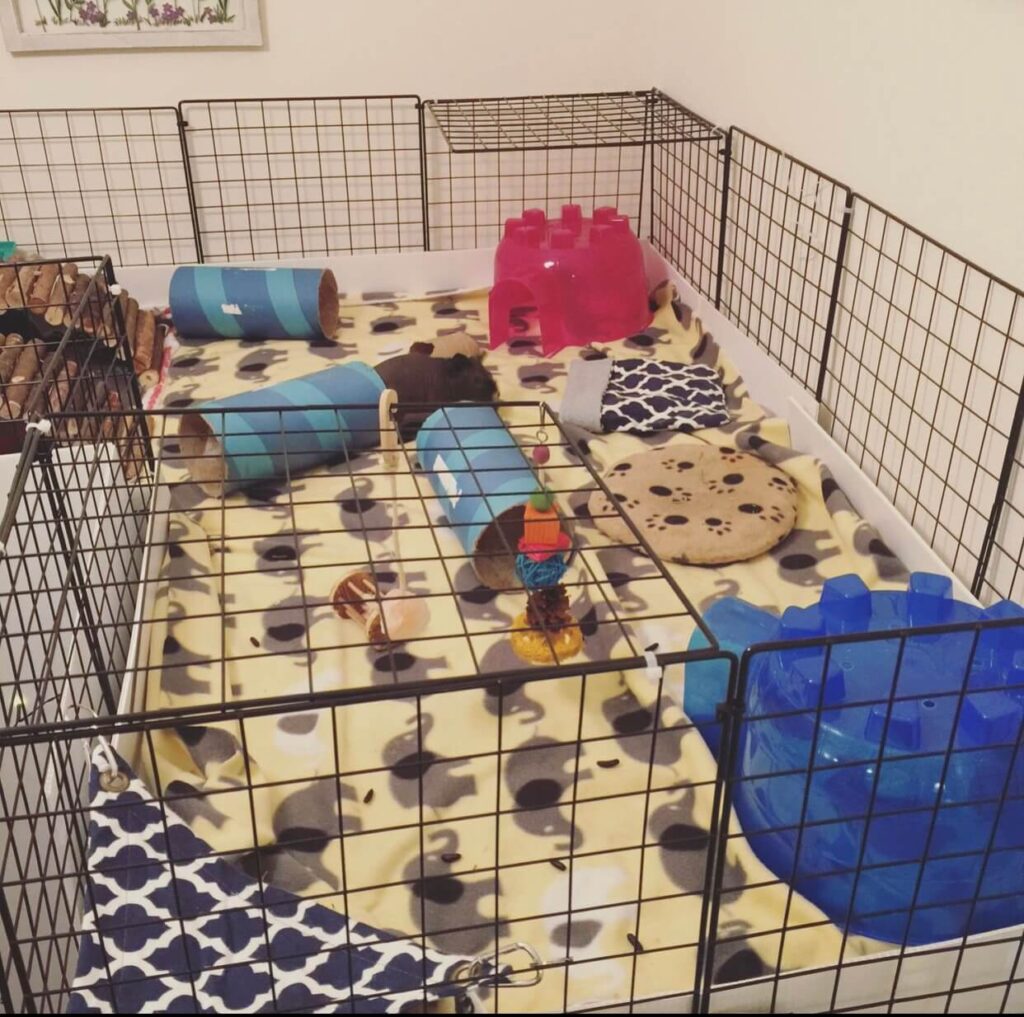
Celebrating National Adopt a Guinea Pig Month

History of the guinea pig:
March is National adopt a guinea pig month! This month’s celebration was created and celebrated by the American Society for the Prevention of Cruelty to Animals in March of 2002. The goal behind this month is to advocate for the responsible ownership of a small mammal species called guinea pigs.
Guinea pigs do not come from Guinea, and they are not actually related to pigs. Guinea pigs are domesticated rodents from South America where they were bred as livestock for households. Back in the 16th century, these little animals were introduced to North America and Europe by Spanish, Dutch, and English traders. They soon gained popularity as pets in households that could afford exotic trade. Owning a guinea pig soon became a thing for those who were deemed of high social status. Queen Elizabeth even owned guinea pigs to show her royal status to society.
In today’s world, many people who cannot own a dog or cat due to allergies or the size of their living space own exotic pets. Guinea pigs may be small in stature but big in personality and make wonderful companions to those who educate themselves in proper care, housing, and handling. At Brook-Falls we see all kinds of guinea pig breeds and these days their owners have a wide range of both social status and age. We pride ourselves in educating owners on the most up-to-date information on diet, handling, and housing requirements to increase their human-animal bond with their guinea pig to the very fullest. Have you considered owning a guinea pig but are not sure if they would be the pet for you? Continue to read this blog for more information on guinea pig ownership basics.
Is a guinea pig the right pet for you?
Guinea pigs have a strong box-shaped body with short legs, large heads, dark eyes, and short round ears. Typically, most healthy guinea pigs weigh about 2-2.5 pounds. A healthy weight is determined by the body shape and size of each breed. Different guinea pig breeds have different hair coat types, colors, and textures. The Abyssinian breed has a medium wavy hair coat. The Skinny breed is hairless over their body but has a little on the tops of their head. The Peruvian guinea pig breed has a long, luscious coat of hair that needs brushing daily to avoid mats. These are just three examples of guinea pig breeds. Healthy guinea pigs who are properly taken care of can live anywhere from five to seven years.
Most people believe that guinea pigs make a good pet for children, however, they require a good amount of help with their attention to pet hygiene, appropriate handling, and specific dietary requirements to maintain good health. Most children will need help monitoring these parameters on a daily basis. Guinea pigs are very active during dusk and dawn periods of the day. During these active times, you should ensure they are eating and eliminating appropriately. If you notice a decrease in either input or output, it can mean a medical emergency. Depending on the age of the owner, some younger owners will need help assessing these parameters.


Guinea pig diet:
HAY
Guinea pigs are herbivores and should have grass hay provided at all times due to the fiber needs of both their GI tracts and their dental system. Their teeth grow continuously throughout their lives and require the fiber to be worn down to the proper shape and size. Grass hays should make up around 80% of their diet. Timothy and orchard grass hay varieties are acceptable to offer to adult guinea pigs. Alfalfa hay should only be offered to guinea pigs under 6 months of age due to the high calcium content which may lead to obesity and bladder stones in older guinea pigs. Brook-Falls suggests the hay brand Oxbow for good quality hay options.
PELLETS
Guinea pigs cannot make their own vitamin C. A deficiency in vitamin C leads to a condition called Scurvy. Scurvy can cause poor appetite, swollen/painful joints, poor bone/teeth development, and spontaneous bleeding from the gums, joints, or muscles. Guinea pig formulated pellets are made to provide the appropriate amount of vitamin C. Be sure that pellets are not greater than 90 days old to ensure they contain the proper amount of vitamin C. Guinea pigs should only be fed 1/8 cup per day and adjust as needed according to your veterinarian’s advice. The company Oxbow makes species-specific pellets for optimal nutritional needs.
FRESH VEGGIES AND FRESH WATER
Pellets are not the only resource for getting vitamin C into your guinea pig. You can add some fresh vegetables to their feedings to encourage the appropriate nutrients for their little bodies. Some examples of excellent sources of vegetables containing vitamin C are red peppers, kale, and parsley. A few good options of vegetables that contain vitamin C are strawberries, Kiwi, and green peppers. A disclaimer should be made that feeding too many fruits may cause loose stools and is not healthy for your guinea pig.
Fresh daily potable water is needed for good health. These guys can drink from either a crock ceramic bowl or a sipper bottle. It is recommended to offer both forms of water delivery vessels to guinea pigs to encourage hydration. It is very important that your vitamin C supplementation is not in your water source as this is not reliable. The best way for vitamin C supplementation is either through tablets or liquids that are given directly by mouth to the guinea pig or through the fresh foods that they eat. For a full list of guinea pig-approved vitamin C vegetables and quantities needed, visit the Veterinary Partner VIN website.
Not only can food provide nutrition, but it also provides environmental enrichment. Sight, smell, taste, and texture, are mentally stimulating to all animals. Just the sound of food preparation can provide guinea pigs with joyful anticipation, and most will “wheek” with anticipation. Fresh veggies can be hidden in hay, crumpled paper, toilet paper rolls, or paper towel rolls. The presentation of the food delivery can provide fun and entertainment for these little critters.

Guinea pig handling:
Guinea pigs that have been well handled, can be approached with a slow hand that is introduced into their enclosure. They are then usually easily scooped into the palm of the handler with their other hand. One hand should be cupped under their rump while the other cradles the pet’s midsection as close to the handler’s body as possible, thus providing the guinea pig with a secure feeling. If a guinea pig is not used to being handled, it may run and jump to get away. Most injuries to guinea pigs come from inexperienced handlers combined with feisty guinea pigs leading to broken limbs or teeth. Children will need education about handling and should be accompanied by an adult while these pets are being handled. Handling should occur on a daily basis for a minimum of thirty minutes.

Guinea pig housing:
Guinea pig housing is limited only to the imagination of its owner. Adequate housing helps maintain the overall health of the guinea pig. They need a dry cool environment with adequate ventilation with solid flooring and appropriate bedding. Bedding materials need to be clean, non-toxic, absorbent, dust-free, and easy to replace. Bedding will need to be cleaned and or replaced often to decrease any possibility of mold growing in their housing environment. Some examples of acceptable beddings are shredded paper, commercially made shredded paper, and or commercially made pellets.
Good ventilation is a must, so most cages have wire on the sides and top to allow for this. The design should be escape-proof, and free of sharp edges and other potential hazards (including noise hazards). About 100 square inches of floor space is needed per adult guinea pig and the top can remain open if the sides are at least 10 inches in height and other family pets are not a threat.
Guinea pigs are social creatures and derive comfort from being able to lean against each other. For this reason, it is best to keep guinea pigs in groups of at least two. At Brook-falls, we provide exotic spay and neuter options to make housing mixed genders without reproduction a possibility.
Brook-Falls and guinea pigs:
If you think you can meet the social and physical needs of guinea pig ownership, please consider adopting one or two to enrich your lives with human-animal companionship. You can start your journey by visiting an adoption center or adoption website. If you are not ready to adopt a guinea pig, please consider sharing this post about adoption within your social media feed. With enough luck, you might inspire somebody to take the plunge and adopt a guinea pig, thereby enriching another life! If you or someone you know adopts a guinea pig, please let them know that we care for this exotic species. Not only do we perform thorough exams, but we share our knowledge of best practices for caring for your new pet.
Please contact us with any questions. Follow this link to schedule an appointment for your guinea pig.
To read further about guinea pigs, check out our education page.
***A special thank you goes out to Kaity for supplying us with wonderful images within this blog and sharing her love of the guinea pig species. This blog is dedicated in memory of the special pigs that have enriched her life but are sadly now gone. May their memory live on forever in the stories she tells of them, and by the other guinea pig lives she helps at Brook-Falls.***
